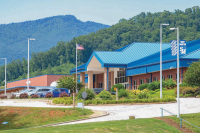Lottery money hardly a win for schools
Keeping a roof over the head of Haywood County’s nearly 8,000 students is getting harder every year as the school system grapples with funding cuts at both the state and county level.
With 16 schools, it’s wise to stay on a steady rotation of replacing a roof every one to two years. Go four years without replacing one, and it is catch up time.
“Then where is the money going to come from? Instead of $1 million project you are looking at a $3 to $4 million project,” said Chuck Francis, chairman of the Haywood County school board. “Now we are at the point where somebody is going to have to step up our schools are going to start going down.”
That’s exactly the message school leaders will be taking to county commissioners this year as they lobby for their maintenance budget to be restored. The county’s annual $600,000 maintenance and repair budget for school buildings was cut to $200,000 four years ago.
“We have to buy light bulbs and fix broken pipes. It’s fixing door knobs and changing locks and keys, and replacing windows that get hit with a rock,” Assistant Superintendent Bill Nolte said. “It is just on and on and on.”
SEE ALSO: Where do schools rank?
Related Items
Commissioners don’t doubt the schools need the money.
Falling behind on upkeep will eventually catch up with the county, agreed County Commissioner Mike Sorrells, a former school board member.
“The longer you prolong this the more behind they are going to get,” Sorrells said. “If you don’t do your preventive maintenance you are going to end up with a huge backlog. So it is like the saying goes ‘pay me now or pay me later.’”
But in this case, the county may have to take the “pay me later” approach, depending on how the coming year’s budget shapes up. (see related article.)
Another routine expense the school system once kept on a regular schedule is replacing activity buses used for field trips, band trips, sports teams and the like. Those activity buses have to come from local dollars — and the money to replace them hasn’t been there.
“We had a schedule plan to increase that, and that has been frozen for three years,” Francis said.
Assault on all fronts
The school system has also lost a pot of state money for building maintenance, repairs and small capital projects. The state once earmarked a share of corporate income tax for school systems, divvied up based on school population around the state.
When the recession hit, the state started keeping that money for itself — resulting in a loss of $270,000 a year.
That puts the school system out a total of $670,000 in building needs.
Meanwhile, however, the Haywood school system has gotten a boost from lottery money. The school got more than $1.4 million last year in lottery money to use for maintenance and capital projects.
When the state started a lottery six years ago, lawmakers promised the money would be a boon for education. Lottery money would not supplant current funding but would be stacked on top of the funding schools already got, lawmakers promised.
Ultimately, it appears lottery money has supplanted other sources of school funding after all, even though it wasn’t supposed to.
Operational money
In addition to school building construction and maintenance money, the county also gives the schools money for operations, nearly $14 million a year. It hires extra teachers that the state won’t pay for, school secretaries, janitors, supplies, and myriad other operational costs not covered by base state funding.
While the county hasn’t cut the schools’ operational budget, it hasn’t grown any either.
About eight years ago the county brokered a deal with the school system designed to curb what had become an annual fight over how much money the county would pony up. Under the deal, the county would use a formula based on student population to determine school funding each year. The formula also built in a 1 percent increase year to year. But it has been frozen for the past 4 years.
Commissioner Mark Swanger, who at the time had just gone from school board chairman to county commissioner, came up with the idea of a formula.
“The formula worked great,” Sorrells said. “Every year, the school system was able to say we are expecting this amount of money.”
Sorrells saw real progress during those years of better funding.
“So it has been disheartening to have to cut back and cut back,” Sorrells said.













